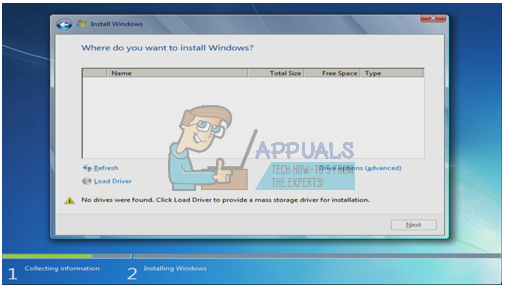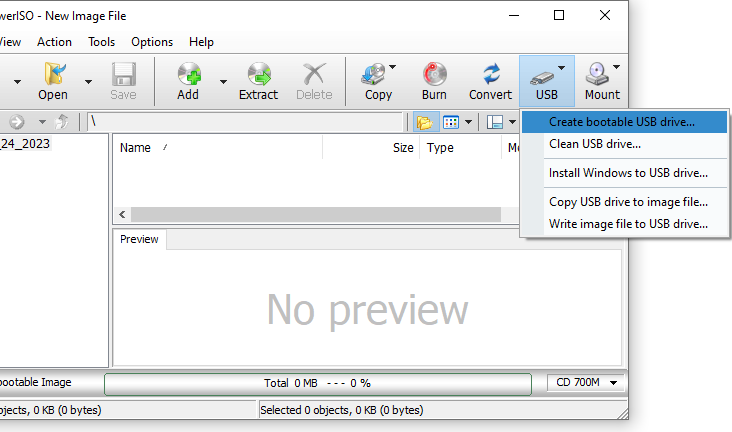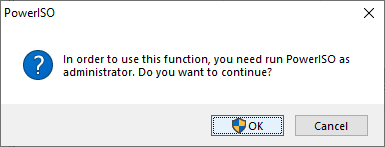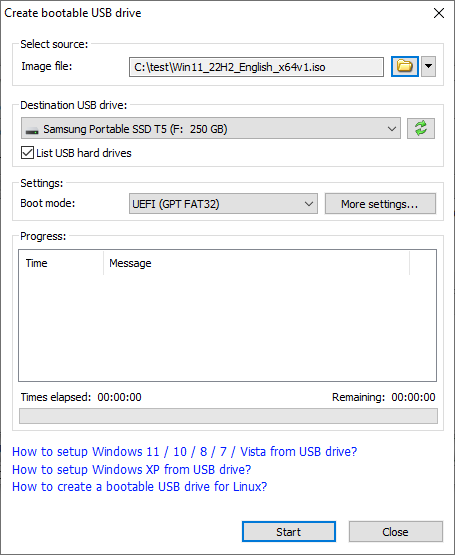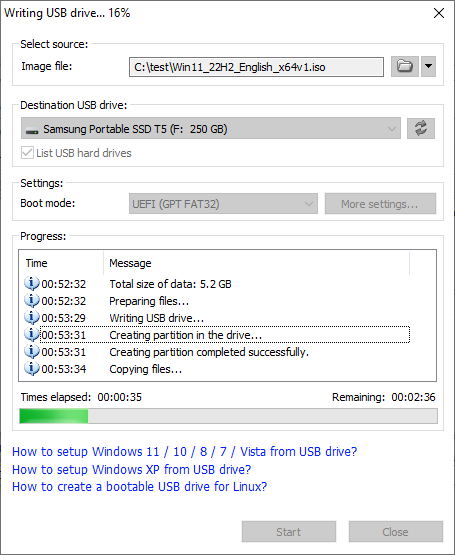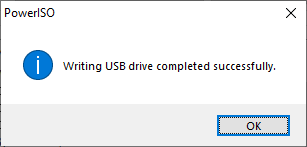Note windows setup to read from usb thumb drive
Windows Setup USB Flash Drive Not Showing Up in BIOS List of Boot Devices
Contents
There are countless articles on how to install Windows 10 from a USB flash drive. Most of them, however, fail to mention a common problem: the USB flash drive does not show up in the BIOS’ list of boot devices. Here is a simple solution that often works.
Penguin USB by Lucius Kwok under CC
Why Install Windows From Scratch?
PC or Laptop vendors do not ship “clean” Windows installations on their devices. Instead, they make any number of changes to the preinstalled OS that may introduce bloat and security issues. Getting rid of all the unwanted modifications is a powerful motivation to install Windows from scratch, specifically on new devices.
Clean Install of Windows: How the Process Should Work
The basic principle is simple:
Problem: USB Flash Drive Does Not Show Up
The process outlined above is simple and painless. Sometimes, however, it breaks at a crucial step: the USB flash drive does not show up in the list of bootable devices. When that happens, a common cause is USB 3.x and the solution is simple: use a USB 2 flash drive. If in doubt: USB 2 flash drives are cheaper and slower, USB 3.x drives are bulkier.
Why is USB 3.x an Issue?
The sad news is that, even in 2020, BIOS support for USB 3.x can be buggy or simply be missing. The problem is not new. Personally, I encountered it as early as 2013 with a Sony Vaio laptop. It took me several hours to identify USB 3 as the root cause. The experience was so frustrating that I used the same “proven” old USB flash drive ever since. Recently though, I got cocky (and also could not find that known good drive): I tried a modern USB 3.x flash drive on a brand-new Dell XPS 15, only to fail miserably. No combination of BIOS settings made the flash drive appear in the list of boot devices. Having exhausted all options (including replacing Media Creation Tool with Rufus) I tried with a dead cheap drive I found on my wife’s desk. It worked instantly. That was when I decided to write this article.
Other Potential Causes
If the USB flash drive does not show up in the BIOS even after switching to a USB 2 device, try the following.
BIOS Settings
Make sure USB boot support is enabled in the BIOS by checking settings like the following (existence and naming depend on your BIOS):
Other tips
If your USB flash drive still does not show up in the list of boot devices give the following a go.
Miscellaneous
Various tips not directly related to USB flash drives not showing up in the list of boot devices.
How to Run Windows 10 From a USB Drive
Loading and running Windows 10 from a USB drive is a handy option when you’re using a computer saddled with an older version of Windows.
You run Windows 10 on your own computer, but now you’re using another PC outfitted with an older operating system. If you prefer to use the newest version of Windows, though, there’s a way to run Windows 10 directly through a USB drive.
You’ll need a USB flash drive with at least 16GB of free space, but preferably 32GB. You’ll also need a license to activate Windows 10 on the USB drive. That means you have to either purchase one or use an existing one that is associated with your digital ID.
You can then use a Windows USB utility to set up the USB drive with Windows 10. Once you’re done, you’ll be able to boot up off the drive to launch Windows 10.
The major downside of booting from a USB drive is that Windows 10 will run slower than it does off your hard drive. But if you’re in a pinch you can at least work with the OS and access different apps this way.
Microsoft once offered its own tool called Windows to Go, which could generate a bootable Windows USB drive with the Enterprise and Education versions of Windows 10. However, the company has stopped development on that program and no longer updates it.
Instead, you can turn to two utility programs, WinToUSB and Rufus. These tools can create a bootable drive from any version of the operating system and on any type of USB drive.
Running Windows 10 From a USB Drive
If you want to run Windows from a USB, the first step is to sign into your current Windows 10 computer and create a Windows 10 ISO file that will be used to install the operating system onto the drive.
To do this, browse to the Download Windows 10 website. This site offers the latest edition of Windows 10, which at this point is the Windows 10 November 2019 Update, or Windows 10 version 1909.
Click the Download tool now button, then double-click the downloaded MediaCreationTool.exe file to install the program. At the first screen for Applicable notices and license terms, click the Access button. Then click the Create installation media (USB flash drive, DVD, or ISO file) for another PC button and hit Next.
At the Select language, architecture, and edition screen, confirm that all of the options are correct and then click Next.
You’ll then need to choose what media you want to use. Given the option between a USB flash drive and an ISO file, click ISO file. Then click Next.
Choose a location on your hard drive to store the Windows.iso file and click Save. Windows 10 will then generate the necessary ISO file. When the process is done, click Finish.
Running WinToUSB
Next, it’s time to enlist the aid of a third-party Windows USB program. Let’s kick things off with WinToUSB. This program comes in three flavors: Free, Professional, and Enterprise.
Start with the free version to see if you like it, but be aware that the freebie poses certain limitations. Most notably, you can create an installation of Windows 10 Home but not Professional or Enterprise.
Next, connect a blank USB flash drive to your computer. Launch WinToUSB from its Start menu shortcut. At the introductory screen, click the button to the right of the Image File field and choose the ISO file you created for Windows 10.
Select the version of Windows 10 you wish to clone onto the USB stick. If you’re using the free version, your only choice is one of the Windows 10 Home versions, so select that one and hit Next.
At the next screen, you’ll need to determine your destination disk. Open the drop-down menu and choose your USB drive. A message pops up asking you to select a partition scheme. Click the MBR for BIOS option and hit Yes.
At the next screen, click the option for Legacy to choose the Installation mode. Click Next and your Windows 10 USB drive will now be created.
When the installation process reaches 100 percent, indicating that it’s finished, close the WinToUSB program and remove the USB drive.
Running Rufus
Now let’s check out Rufus. Download and install the Rufus program from its website, then launch the software. At the Drive Properties window, select your USB drive in the Device field, if it’s not already selected. Click the Select button next to the Boot selection field and select your Windows 10 ISO file.
Click the Image option field and change it to Windows to Go. You can leave the other options at their default values. If you wish, change the Volume label to something like Windows 10. Then click the Start button.
At the next screen, choose the version of Windows that you want to run on the USB drive, then click OK. A warning message flashes that all data on your USB drive will be destroyed. Click OK to continue.
Rufus will now copy the necessary files to the USB drive. After the USB drive has been set up, close the Rufus window.
Launch Windows 10 With USB
When you want to launch Windows 10 on a different computer, insert your USB drive into that PC. Press the appropriate key to launch your Boot menu and choose the option to boot up off the USB drive. The easiest way is to hold the Shift key and restart the computer.
The first time you run Windows 10 off the USB drive, you’ll need to go through the familiar Windows setup process. You’ll also need to activate Windows 10.
You can then install apps onto the USB drive and access any files or documents stored online, so the experience comes close to working on one of your own Windows 10 PCs.
Fix: No Hard Drives Found in Windows 7 Installer
Windows 7 was hands down the most popular operating system. Since Windows 10 is relatively new and has had its share of bugs and incompatibility, Windows 7 is still being used by millions of people as an alternative. This means that people are still actively buying Windows 7 licenses and installing the operating system on their PC. However, there is a common problem where the Windows 7 setup does not recognize the hard drive that you want to install into. All you see on the setup is a blank list box when it comes to choosing a drive to install into. There is also a vague message preceded by an exclamation in a yellow triangle stating “No drivers found Click load driver to provide a mass storage driver for installation.” This article will explore this problem, give the reasons why it occurs and finish off by giving you working solutions to the problem.
Why Windows 7 Setup cannot find your hard drive
In order to read the hard drive, Windows must have the motherboard storage controller drivers, unlike the BIOS setup. Windows setup usually loads all the hard disk drivers but if your motherboard was unveiled after the release of Windows 7, then there is a likelihood that your drivers are not loaded hence the hard disk cannot be detected. You might see the hard drive in the BIOS setup but the Windows setup will not be able to find it.
Another common reason why your hard drive cannot be detected in the volume file format. Windows usually read NTFS file format, so if your hard disk is new or was previously used in Ubuntu, Mac or Linux, there is a possibility that its file format is unreadable by the Windows setup.
The motherboard and hard drives also connect in different ways (dictated by the motherboard storage controller) which determines how data is exchanged to and from the drive and the interface that is used in BIOS. This includes EFI/UEFI, SATA/IDE, SATA/ATA, SATA/AHCI, and SATA/RAID. Using the wrong connection protocol can lead to a conflict hence your hard drive will not be detected by the BIOS and by Windows setup.
Below is how you can resolve this issue. Start with this method 3, 4 & 5 if your BIOS is not able to detect your hard disk.
Method 1: Format/Clean the Hard drive using ‘diskpart’ in command prompt
If your hard drive is detected by BIOS then using the “clean” command will format the hard drive and set the NTFS file format. You will lose any data that was saved in the hard disk so use this method if you are absolutely sure you don’t need the data in the hard drive.
Alternatively, remove your HDD, slave it to a machine that already has Windows and format the drive using an NTFS file system. When finished, fix the HDD back on your machine and start your win7 installation.
Method 2: Load the hard drive storage controller drivers from a USB into the Windows setup
If your SATA/storage controller is newer than your Windows 7 version, then this method will load the missing storage controller drivers needed to detect your hard disk.
Method 3: Change the boot controller mode in BIOS
This method will help if your BIOS cannot detect the hard drive. By changing to the correct BIOS interface and data exchange mechanism, the Windows 7 setup will be able to find your hard drive. You have the option of EFI/UEFI or SATA that has four boot modes (ATA, RAID, IDE, AHCI).
If you are using RAID on your computer, change it to AHCI or IDE. Otherwise, just change whatever controller is selected and check to see if the issue persists. After doing so, format the disk using the first method or you can also use Acronis True Image to complete the formatting process.
UEFI motherboard might miss this option since they only have one type of storage controller protocol. Note that this method and the controller mode options might be different for different computers. You can get the controller mode under “Host controller” “IDE Configuration” “SATA configuration” or something similar.
Method 4: Reset BIOS
If you changed the storage controller configuration due to an update of any sort, you could try resetting your BIOS.
Method 5: Use a different SATA port
If you are using a desktop computer, try using a different SATA port and see if that helps at all. Sometimes they come with two different controllers.
Note: Sometimes, copying the Boot Folder from the Windows install Disk to the USB drive fixes this particular issue so you can have a go at that.
NOTE: These instructions reference Windows 10, but they work just as well if you want to create a bootable copy of Windows 7 or Windows 8.
Technical Level : Basic
Summary
If you performing a new installation of Windows 10, you might need to prepare bootable install media. The Media you choose to install from will depend on certain factors, such as the Boot Scheme used by your computer (BIOS, UEFI) in addition to the storage device (hard disk partitioning layout). Examples of partitioning layout include MBR (BIOS) and GPT (UEFI). In this article, we show you several ways to create a bootable copy of Windows 10 from an ISO file. An ISO file is a digital replica of a virtual disc, which users will have to make bootable on a blank DVD, USB thumb drive or SD card.
Details
Before we begin, you need to have a copy of Windows 10 ISO file. See the following article for instructions how to download a ISO image for Windows 10 using the Media Creation Tool:
NOTE: Microsoft no longer provides direct access to Windows 10 ISO images from the Microsoft Techbench website for computers running Windows 7, Windows 8.0, Windows 8.1 and Windows 10. You can still download the ISO image from computers running earlier versions of Windows such as Windows XP, Windows Vista or alternative operating systems such as Linux or macOS.
After downloading the Windows 10 ISO, you need prepare it, this is especially important for Windows 7 and earlier versions of Windows.
Insert a blank DVD
Important:
If you are creating a bootable USB thumb drive, make sure the thumb drive is first formatted as FAT32.
Connect the thumb drive
Right click thumbdrive
Make sure FAT32 is selected as the file system.
For UEFI based systems
If your computer is UEFI based, these are normally systems that come pre-loaded with Windows 8 or later, you will need to prepare the ISO file for such a configuration or you will receive an error message during setup. The thumb drive needs to be formatted as FAT32. If you are installing on a hard disks that is 4 TBs or more in size, you need to format the disk using the GPT partitioning scheme. Rufus ensures your copy of Windows 10 is properly prepared to support it.
After downloading Rufus, connect your thumb drive, launch Rufus application, click in the Device list box then choose your thumb drive.
Click in the list box then choose your partition scheme. If you select the ISO, Rufus will automatically select the appropriate options for you. Next, click in the File system list box, then choose FAT32. If your thumb drive is larger than 32 GBs, choose exFAT.
Leave the default Cluster size then enter a label for your thumb drive.
Click the choose disk image icon, browse to where the ISO file is located, select it then click Open.
Click Start to copy the files to the thumb drive.
If you have any files on the thumb drive, they will be deleted.
Wait while the files are copied to your thumb drive.
Close when complete
Open File Explorer, then launch setup to begin the installation.
If you are performing a clean install see instructions how to configure your BIOS or UEFI firmware:
Was this article helpful?
Sorry this didn’t help.
Great! Thanks for your feedback.
How satisfied are you with this article?
Thanks for your feedback, it helps us improve the site.
Note windows setup to read from usb thumb drive
Step1: Create Bootable USB Drive
Start PowerISO (v6.5 or newer version, download here).
Insert the USB drive you intend to boot from.
Choose the menu «Tools > Create Bootable USB Drive». The «Create Bootable USB Drive» dialog will popup. If you are using Windows Vista or above operating system, you need confirm the UAC dialog to continue.
In «Create Bootable USB Drive» dialog, click «. » button to open the iso file of Windows operating system.
Select the correct USB drive from the «Destination USB Drive» list if multiple USB drives are connected to the computer.
Choose the proper writing method. «USB-HDD» is recommended.
Click «Start» button to start creating bootable USB drive.
PowerISO will alert you that all data on USB drive will be destroyed. Click «OK» to continue.
The program will start writing USB drive, and showing the progress information. You should get the message «Writing USB drive completed successfully.» after the operation completes.
If no errors occurred in the above process, you should now be all set to setup Windows from USB drive!
Step 2: Configuring the BIOS
You should now reboot and go into the BIOS configuration to boot from USB. Instructions for doing so vary wildly from system to system, but generally entail the following:
While booting (before Windows starts loading), get into the BIOS configuration screen by hitting something like F1, F2, Delete or Escape. Hotkey instructions are generally provided on the screen.
Go to the section that contains your boot devices.
With your USB drive plugged in, the USB drive should be listed. If it isn’t, your system might not support booting from USB. Assuming that it is supported (as is the case with virtually all modern hardware), promote your USB drive to the primary boot device.
Exit from the BIOS configuration, saving all changes.
Please notice that you can seriously screw up your system by providing incorrect BIOS settings!
Step 3: Booting and setup windows from USB drive
Assuming that you properly configured your BIOS and your USB drive supports booting, Windows setup should now load. Depending on the speed of your USB drive, this may take a while.
If it isn’t working, then double-check the following before making a scene:
Is your BIOS properly configured for booting from the USB device? (Is the USB device listed and does it have top priority?)
Have you correctly prepared the USB drive in step one? (Restart the procedure.)
Does your USB drive properly support being booted from? (Try another one!)



